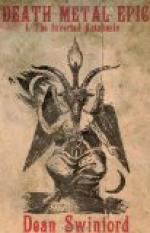We are told that the Ramayana inspired the greatest poet of Mediaeval India, Tulsi Das, to compose the Ram Charit Manas, an epic wherein he gives a somewhat shorter and very popular version of Rama’s adventures. This work still serves as a sort of Bible for a hundred million of the people of northern India.
The poet Kaviraja (c. 800 A.D.) composed an epic wherein he combines the Ramayana and Mahabharata into one single poem. This is a Hindu tour de force, for we are told that “the composition is so arranged that by the use of ambiguous words and phrases the story of the Ramayana and the Mahabharata is told at one and the same time. The same words, according to the sense in which they are understood, narrate the events of each epic.”
THE RAMAYANA
This Hindu epic, an older poem than the Mahabharata, was composed in Sanscrit some five hundred years before our era, and is contained in seven books, aggregating twenty-four thousand verses. It is often termed “the Odyssey of the East,” and relates events which are said to have occurred between two thousand and nine hundred B.C. The poem is generally attributed to Valmiki, a hermit on the bank of the Ganges, who, seeing one bird of a happy pair slain, made use of a strange metre in relating the occurrence to Brahma. This god immediately bade him employ the same in narrating the adventures of Rama, one of the seven incarnations of the god Vishnu.
“Praise to Valmiki, bird of charming
song,
Who mounts on Poesy’s sublimest
spray,
And sweetly sings with accents clear and
strong
Rama, aye Rama, in his deathless lay."[41]
The poem opens with a description of the ancient city of Ayodhya (Oude), beautifully situated on the banks of a river and ruled by a childless rajah.
In by-gone ages built and planned
By sainted Manu’s princely hand,
Imperial seat! her walls extend
Twelve measured leagues from end to end;
Three in width, from side to side
With square and palace beautified.
Her gates at even distance stand,
Her ample roads are wisely planned.
Right glorious is her royal street,
Where streams allay her dust and heat.
On level ground in even row
Her houses rise in goodly show.
Terrace and palace, arch and gate
The queenly city decorate.
High are her ramparts, strong and vast,
By ways at even distance passed,
With circling moat both deep and wide,
And store of weapons fortified.
This monarch (Dasaratha), a descendant of the moon, was sixty thousand years old when the story begins. Although his reign had already extended over a period of nine thousand years,—during which his people had enjoyed such prosperity that it is known as the Age of Gold,—the king, still childless in spite of having seven hundred and fifty concubines, decided to offer a great horse sacrifice (asvatmedha) in hopes of obtaining a son, to celebrate his funeral rites and thereby enable him to enter heaven.




